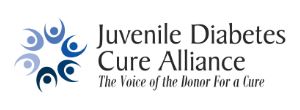Top Qs
Timeline
Chat
Perspective
Juvenile Diabetes Cure Alliance
From Wikipedia, the free encyclopedia
Remove ads
The Juvenile Diabetes Cure Alliance (JDCA) is a registered 501(c)(3) non-profit organization dedicated to developing a Practical Cure for type 1 diabetes. The organization advocates for increasing type 1 diabetes cure research and publishes reports on a variety of related topics, including research progress, fundraising utilization, and donor priorities. Established in 2010, the organization’s home office is in New York City and it focuses primarily on activity within the United States.
Remove ads
Activities include research, publishing, and advocating for T1D donors. All activities serve the nonprofit's ultimate purpose of bringing about what the organization calls a "Practical Cure" for type 1 diabetes.[1]
The organization defines a Practical Cure as any solution that gives people living with the disease the chance to live a normal, unrestricted life. The clinical requirements of a Practical Cure are defined by those living with T1D who understand the daily burden. Practical Cure requirements include testing blood sugars once a week or less, eating an unrestricted diet, a greatly reduced and simple regimen of medication, sleeping worry-free, experiencing minimal to no diabetes side effects, and experiencing fast recovery from surgeries.[2]
Remove ads
History
The JDCA was founded in 2010 by Brian Kelly, former Chairman of the Board of Activision Blizzard, after his son was diagnosed with type 1 diabetes at the age of two. Kelly founded the organization to accelerate a cure for type 1 diabetes within his son’s lifetime.
At the time of its founding, the JDCA adopted a business, results-focused perspective in an effort to hold major diabetes fundraising nonprofit organizations accountable for the absence of measurable progress tracking and a lack of transparency to the donor public.[3] One key theme maintained as the organization has evolved is that donor priorities and the utilization of funds by major fundraisers should be aligned.[4]
As of 2024, the JDCA has published over 500 reports on topics related to finding a cure for type 1 diabetes. These reports include updates to existing human clinical trials with the potential to become Practical Cures, financial analysis of the top nonprofit organizations, breaking news in T1D research, and others.

Remove ads
Research and publishing
Summarize
Perspective
Between 30 and 40 reports are published per year on the Juvenile Diabetes Cure Alliance website and sent via email. All reports are free to the public to increase awareness and access to information regarding current developments in the T1D research ecosystem. There are four main types of reports: Type 1 diabetes human trials research, utilization of funds by large diabetes nonprofits and public sources, donor sentiment, and an annual State of the Cure for Type 1 Diabetes publication.
Human trials research progress
The JDCA tracks and categorizes type 1 diabetes potential Practical Cure research projects that are in human trials or about to start human trials. The list of projects is updated twice a year. While most projects have remained constant, some have been removed over time for insufficient test results and new ones have been added.[5]
State of the Cure
The State of the Cure for Type 1 Diabetes (SOTC) provides an annual overview of progress toward a T1D cure throughout the year.[6] SOTC reflects on the challenges, advancements, and steps needed to move forward with finding a Practical Cure.
Utilization of funds
The organization evaluates the publicly available financial documents of major diabetes charities and publishes reports on how funds are utilized.[7] Topics covered include research grant allocation, research funding priorities, CEO compensation, and analyzing cure-based marketing versus cure-based funding. The purpose is to foster transparency, bring attention to discrepancies in research funding, and provide recommendations to larger, influential nonprofits to improve donor loyalty and expedite research progress. Breakthrough T1D and the American Diabetes Association are the common focus of this reporting.
The organization also believes that nonprofit executive pay should be primarily incentive-based; tied to both organizational advancements and tangible progress toward a T1D cure and treatment.[8] The JDCA also advocates for a donor Say on Pay model, in which donors would have a say in executive compensation, promoting accountability to nonprofit employees.
At the highest-performing for-profit companies, top executives’ annual compensation is often directly correlated to performance. The better the company does, the more executives are rewarded. This form of incentive creates a powerful professional and personal zeal to drive the company toward palpable results that benefit stakeholders and shareholders alike. This business model does not usually carry over to nonprofit organizations. The JDCA believes this is a missed opportunity to drive passion, accentuate focus, and improve overall performance toward achieving organizational goals.
Donor sentiment
Based on survey results, the JDCA publishes multiple annual reports that detail the sentiments of the T1D community, specifically regarding priorities and values. A consistent finding is that the number one priority of the T1D donor community is developing a cure for type 1 diabetes. According to annual community surveys, 97% of T1D donors say that the number one reason they donate is to fund cure research.[8]
Remove ads
Advocating for an increase in type 1 diabetes research
The JDCA advocates for a significant increase in spending on cure research for type 1 diabetes through annual petitions.[9] Its activities have fostered some discussion within the diabetes community.[10] The 2023 9th Annual More for a T1D Cure petition to increase cure funding acquired 388,000 signatures.[11]
The JDCA also provides services for donors who want to legally stipulate how their gifts will be used.[12][13]
Criticism
The JDCA’s approach has been controversial for its focus on outcomes and expediency rather than traditional methods of deciding what projects to fund.[14]
Critics of the JDCA have stated that the definition of a cure can vary depending on who you ask. Others argue that a cure by 2035 is unobtainable and that improved diabetes treatments are a more valid outlet for funding than the JDCA acknowledges.[15]
Remove ads
References
Wikiwand - on
Seamless Wikipedia browsing. On steroids.
Remove ads

